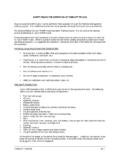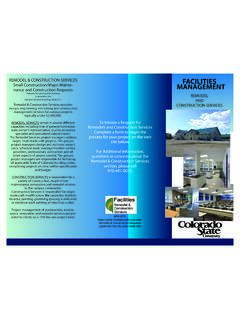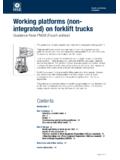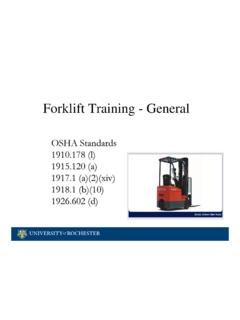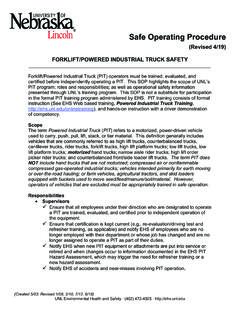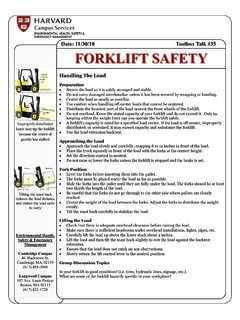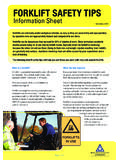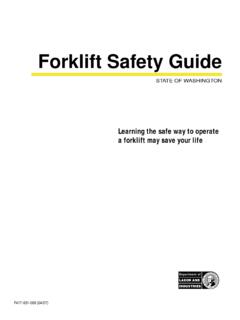Transcription of SAFETY RULES FOR OPERATION OF FORKLIFT TRUCKS
1 SAFETY RULES FOR OPERATION OF FORKLIFT TRUCKS . Anyone using the FORKLIFT TRUCKS must be certified in their OPERATION through the Facilities Management training program. Non-certified personnel are not to operate this equipment under any circumstances. The National SAFETY Council FORKLIFT truck Operators Training Course is to be used as the primary source of reference for use of FORKLIFT TRUCKS . These procedures have been prepared to provide a basic source of reference and a means of uniformity for use of FORKLIFT TRUCKS . When a question arises that cannot be suitably answered by reference to these operating procedures, it is suggested the Operator's manual be consulted or the matter be discussed with the supervisor.
2 PHYSICAL QUALIFICATIONS FOR OPERATORS. No physical or mental condition that would jeopardize the safe OPERATION of the truck (dizzy spells, medication, bad back, etc.). Good vision, of at least 20/40, corrected if necessary; depth perception of at least 90 percent of normal. Wearing vision protection is recommended at all times. Normal hearing, preferably without need of a hearing aid. Normal reflexes and reaction time. No use of illegal substances; no excessive use of alcohol. Ability to understand and read instructions, signs, etc. PRE-SHIFT INSPECTION.
3 A pre-shift inspection of the FORKLIFT truck is required before the equipment is used. The following items must be checked before operating the equipment: Fuel level and gauge. Oil level. Hydraulic oil level. Powershift oil level. Battery water level. Visual inspection of battery for corrosion and loose terminals. Coolant water level. Visual inspection of the fan belt. Brakes for proper OPERATION both service and parking. Lights head, tail, turn, and warning. Horn. Hoist mechanism: chain bearings, nuts, and cotters. Lube as required. Also check the forks for cracks, heel wear, tip wear, and alignment.
4 Steering. Hydraulic controls. Tires: remove foreign material and check inflation. Visual inspection for oil, fuel, and exhaust leaks. At the end of the usage, all the above items must be checked again. In addition, the operator must place all controls in neutral and set the parking brake. During the winter, the engine heater must be plugged in if the unit is so equipped. FORKLIFT TRUCKS 20-1. The Operators Daily Report must be filled out during both the pre-use and post-use inspections and turned in to Transportation Services, along with the keys to the equipment, at the end of use.
5 LIFT truck OPERATION . Only certified personnel may operate the FORKLIFT TRUCKS . You must show both your driver license and a valid Facilities Management Certified Operator's card at Transportation Services to get the keys to the equipment. No certified operator may check the equipment out and then turn it over to a non-certified operator. This action will result in revocation of certification and possible disciplinary action. Leaving the truck : Whenever the operator leaves the truck , the forks or attachment must be fully lowered, the controls set in neutral, and the parking brake set.
6 If the operator goes 25 feet or more away from the truck , or is out of sight of the truck , the engine must be shut off, and the operator must have the key in his or her possession. Visibility: The operator must always have a clear view of the path in the direction of travel. If the load being carried blocks forward view, the driver must travel with the load trailing. Load handling: Only stable and safely arranged loads within the rated capacity of the truck should be handled. Operators are not to pick up and move loads that are too heavy. If, upon attempting to lift the load, the rear wheels of the truck begin to rise, set the load down immediately and obtain proper equipment to lift a load of that size.
7 When picking up a load, center the load evenly on the forks, and engage loads squarely until the load rests against the vertical portion of the forks or load backrest. Check the fork length. Forks must be at least 2/3 the length of the load. Carefully tilt the mast backward just enough to stabilize the load. Forks on a lift truck are adjustable; spread them to fit the load. Normally, the wider the better. Loads can be of many sizes and descriptions. Many lift truck applications handle loads on pallets. Pallets are loaded with boxes, bags, packages, or other small objects.
8 All loads should be made stable by either interlocking the objects, or strapping or shrink-wrapping the load, to prevent individual objects from falling off the pallet. Long loads, such as carpet rolls, reduce the stability of a lift truck . Long, wide, or high loads require more room, so watch the clearance. The load may be very secure until something is run into that shifts the truck 's center of gravity. This creates the potential for a lateral overturn. Lifting long loads that extend directly in front changes the weight center of the truck and reduces the lifting capacity of the truck .
9 When right angle stacking or moving with a raised load to clear low objects, move very slowly and avoid sharp turns. When raising a load, use extra caution. An elevated load must not be tilted forward except when the load is in the correct position to be deposited. When stacking, use only enough backward tilt to stabilize the load. Operating surfaces: Operate the FORKLIFT TRUCKS only on improved surfaces if possible. If operating off of improved surfaces, make sure the surface will support the weight of the vehicle and not create unstable conditions before entering the area.
10 On grades, ramps, slopes, and inclines, travel straight up and down. Never turn on ramps, slopes, inclines, or severe grades; wait until you are back on a level surface. Never try to cross a ramp, slope, incline, or severe grade perpendicular to the fall line. This creates the potential for a lateral overturn. Without a load, travel up or down with the forks pointing downgrade. FORKLIFT TRUCKS 20-2. Pedestrians: The operator of the FORKLIFT truck is responsible for operating in a safe manner;. this includes avoiding all pedestrians in the work area.
